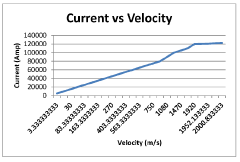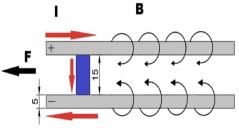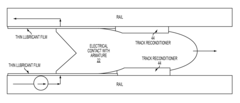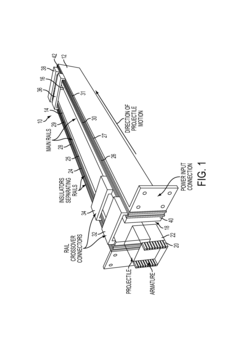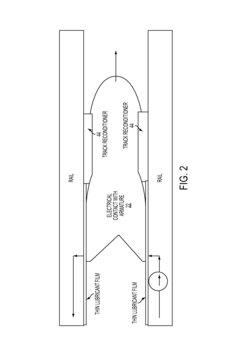Assessing Hidden Cost Factors in Rail Gun Implementation
AUG 6, 20259 MIN READ
Generate Your Research Report Instantly with AI Agent
Patsnap Eureka helps you evaluate technical feasibility & market potential.
Rail Gun Tech Background and Objectives
Rail guns, a revolutionary electromagnetic projectile launcher technology, have been the subject of extensive research and development since the early 20th century. Initially conceptualized by French inventor Louis Octave Fauchon-Villeplee in 1918, rail guns have evolved from theoretical concepts to practical prototypes, capturing the imagination of military strategists and scientists alike.
The fundamental principle behind rail gun technology involves using electromagnetic forces to accelerate a conductive projectile along a pair of metal rails. This approach offers significant advantages over traditional chemical propellants, including higher muzzle velocities, extended range, and the potential for reduced logistical burdens associated with conventional ammunition.
Over the decades, rail gun development has been driven by the pursuit of several key objectives. Foremost among these is the goal of achieving unprecedented projectile velocities, potentially exceeding Mach 7, which would revolutionize long-range strike capabilities and anti-air defense systems. Another critical objective is to enhance the weapon's durability and reliability, addressing challenges such as rail erosion and power supply limitations that have historically hindered practical implementation.
The evolution of rail gun technology has been closely tied to advancements in materials science, power electronics, and energy storage systems. Recent progress in these fields has reignited interest in rail guns, with several nations investing heavily in research and development programs aimed at overcoming longstanding technical hurdles.
As we assess the hidden cost factors in rail gun implementation, it is crucial to understand the technology's current state and its potential trajectory. While rail guns offer promising capabilities, their development and deployment face significant challenges, including high energy requirements, complex cooling systems, and the need for specialized infrastructure.
The objectives of contemporary rail gun research extend beyond mere technological feasibility. There is a growing emphasis on developing systems that are not only powerful and accurate but also practical for field deployment. This includes addressing issues of size, weight, and power consumption to create rail gun systems that can be integrated into existing military platforms, such as naval vessels or mobile ground units.
Furthermore, the strategic implications of rail gun technology have broadened the scope of research objectives. Beyond their potential as direct-fire weapons, rail guns are being explored for their capabilities in missile defense, space launch applications, and even as tools for scientific research in high-energy physics and materials testing.
The fundamental principle behind rail gun technology involves using electromagnetic forces to accelerate a conductive projectile along a pair of metal rails. This approach offers significant advantages over traditional chemical propellants, including higher muzzle velocities, extended range, and the potential for reduced logistical burdens associated with conventional ammunition.
Over the decades, rail gun development has been driven by the pursuit of several key objectives. Foremost among these is the goal of achieving unprecedented projectile velocities, potentially exceeding Mach 7, which would revolutionize long-range strike capabilities and anti-air defense systems. Another critical objective is to enhance the weapon's durability and reliability, addressing challenges such as rail erosion and power supply limitations that have historically hindered practical implementation.
The evolution of rail gun technology has been closely tied to advancements in materials science, power electronics, and energy storage systems. Recent progress in these fields has reignited interest in rail guns, with several nations investing heavily in research and development programs aimed at overcoming longstanding technical hurdles.
As we assess the hidden cost factors in rail gun implementation, it is crucial to understand the technology's current state and its potential trajectory. While rail guns offer promising capabilities, their development and deployment face significant challenges, including high energy requirements, complex cooling systems, and the need for specialized infrastructure.
The objectives of contemporary rail gun research extend beyond mere technological feasibility. There is a growing emphasis on developing systems that are not only powerful and accurate but also practical for field deployment. This includes addressing issues of size, weight, and power consumption to create rail gun systems that can be integrated into existing military platforms, such as naval vessels or mobile ground units.
Furthermore, the strategic implications of rail gun technology have broadened the scope of research objectives. Beyond their potential as direct-fire weapons, rail guns are being explored for their capabilities in missile defense, space launch applications, and even as tools for scientific research in high-energy physics and materials testing.
Market Analysis for Rail Gun Systems
The market for rail gun systems is experiencing significant growth and transformation, driven by increasing defense budgets and the need for advanced long-range artillery capabilities. As nations seek to modernize their military arsenals, rail guns have emerged as a promising technology with the potential to revolutionize naval and ground-based artillery systems.
The global market for rail gun systems is projected to expand substantially over the next decade. This growth is primarily fueled by major military powers investing in research and development of electromagnetic launch technologies. The United States, China, and Russia are at the forefront of rail gun development, with other nations such as India, Japan, and several European countries also showing interest in this technology.
Naval applications currently dominate the rail gun market, as these systems are particularly well-suited for ship-based deployment. The ability to launch projectiles at hypersonic speeds over extended ranges makes rail guns an attractive option for naval warfare and coastal defense. Additionally, there is growing interest in land-based rail gun systems for both offensive and defensive purposes.
The market is segmented into various components, including power supply systems, projectiles, cooling systems, and launch platforms. Each of these segments presents unique opportunities for manufacturers and suppliers in the defense industry. Power supply systems, in particular, represent a critical area for innovation, as the high energy requirements of rail guns pose significant technical challenges.
Despite the promising outlook, the rail gun market faces several challenges. The high costs associated with research, development, and implementation of these systems remain a significant barrier to widespread adoption. Additionally, technical hurdles such as barrel wear, power management, and system reliability need to be overcome to make rail guns a viable alternative to conventional artillery.
Geopolitical factors also play a crucial role in shaping the rail gun market. International arms control agreements and export regulations may impact the development and proliferation of this technology. Furthermore, the strategic implications of rail gun deployment could influence military doctrines and defense strategies, potentially reshaping the global balance of power.
As the technology matures, the rail gun market is expected to diversify beyond military applications. Potential civilian uses, such as space launch systems and high-speed impact testing, could open up new market segments. This diversification may lead to increased investment from private sector entities, further driving innovation and cost reduction in rail gun technologies.
The global market for rail gun systems is projected to expand substantially over the next decade. This growth is primarily fueled by major military powers investing in research and development of electromagnetic launch technologies. The United States, China, and Russia are at the forefront of rail gun development, with other nations such as India, Japan, and several European countries also showing interest in this technology.
Naval applications currently dominate the rail gun market, as these systems are particularly well-suited for ship-based deployment. The ability to launch projectiles at hypersonic speeds over extended ranges makes rail guns an attractive option for naval warfare and coastal defense. Additionally, there is growing interest in land-based rail gun systems for both offensive and defensive purposes.
The market is segmented into various components, including power supply systems, projectiles, cooling systems, and launch platforms. Each of these segments presents unique opportunities for manufacturers and suppliers in the defense industry. Power supply systems, in particular, represent a critical area for innovation, as the high energy requirements of rail guns pose significant technical challenges.
Despite the promising outlook, the rail gun market faces several challenges. The high costs associated with research, development, and implementation of these systems remain a significant barrier to widespread adoption. Additionally, technical hurdles such as barrel wear, power management, and system reliability need to be overcome to make rail guns a viable alternative to conventional artillery.
Geopolitical factors also play a crucial role in shaping the rail gun market. International arms control agreements and export regulations may impact the development and proliferation of this technology. Furthermore, the strategic implications of rail gun deployment could influence military doctrines and defense strategies, potentially reshaping the global balance of power.
As the technology matures, the rail gun market is expected to diversify beyond military applications. Potential civilian uses, such as space launch systems and high-speed impact testing, could open up new market segments. This diversification may lead to increased investment from private sector entities, further driving innovation and cost reduction in rail gun technologies.
Current Challenges in Rail Gun Development
Rail gun technology, while promising in its potential for revolutionizing military and space applications, faces several significant challenges in its current development stage. These obstacles span across technical, operational, and economic domains, hindering the widespread implementation of rail guns.
One of the primary technical challenges is the issue of rail erosion. The intense electromagnetic forces and high temperatures generated during firing cause rapid wear on the rails, significantly reducing their lifespan. This erosion not only affects the performance and accuracy of the weapon but also necessitates frequent and costly replacements, impacting the overall operational efficiency and economic viability of rail gun systems.
Power supply and energy storage present another major hurdle. Rail guns require enormous amounts of electrical energy to be delivered in extremely short time frames. Current power generation and storage technologies struggle to meet these demanding requirements while maintaining a form factor suitable for mobile platforms. This limitation restricts the practical deployment of rail guns, particularly in naval applications where space and weight constraints are critical.
The projectile design for rail guns also poses significant challenges. Unlike conventional ammunition, rail gun projectiles must withstand extreme acceleration forces and electromagnetic fields. Developing projectiles that can maintain structural integrity under these conditions while also delivering the desired terminal effects is an ongoing area of research and development.
Thermal management is another critical issue facing rail gun development. The rapid discharge of electrical energy generates intense heat, which can lead to component failure and reduced system reliability. Effective cooling systems that can dissipate this heat quickly and efficiently, without adding excessive weight or complexity to the system, are yet to be fully realized.
Additionally, the electromagnetic interference (EMI) generated by rail guns presents operational challenges. The strong electromagnetic fields produced during firing can disrupt sensitive electronic systems on the host platform and nearby equipment. Mitigating this EMI without compromising the performance of the rail gun or other critical systems remains a significant engineering challenge.
Lastly, the integration of rail gun technology into existing military platforms and doctrines poses both technical and operational challenges. Adapting current naval vessels or land-based systems to accommodate the unique requirements of rail guns, including power generation, cooling systems, and fire control, requires substantial modifications and investments. Furthermore, developing new tactical and strategic doctrines to effectively utilize rail gun capabilities within existing military frameworks is an ongoing process that requires extensive testing and evaluation.
One of the primary technical challenges is the issue of rail erosion. The intense electromagnetic forces and high temperatures generated during firing cause rapid wear on the rails, significantly reducing their lifespan. This erosion not only affects the performance and accuracy of the weapon but also necessitates frequent and costly replacements, impacting the overall operational efficiency and economic viability of rail gun systems.
Power supply and energy storage present another major hurdle. Rail guns require enormous amounts of electrical energy to be delivered in extremely short time frames. Current power generation and storage technologies struggle to meet these demanding requirements while maintaining a form factor suitable for mobile platforms. This limitation restricts the practical deployment of rail guns, particularly in naval applications where space and weight constraints are critical.
The projectile design for rail guns also poses significant challenges. Unlike conventional ammunition, rail gun projectiles must withstand extreme acceleration forces and electromagnetic fields. Developing projectiles that can maintain structural integrity under these conditions while also delivering the desired terminal effects is an ongoing area of research and development.
Thermal management is another critical issue facing rail gun development. The rapid discharge of electrical energy generates intense heat, which can lead to component failure and reduced system reliability. Effective cooling systems that can dissipate this heat quickly and efficiently, without adding excessive weight or complexity to the system, are yet to be fully realized.
Additionally, the electromagnetic interference (EMI) generated by rail guns presents operational challenges. The strong electromagnetic fields produced during firing can disrupt sensitive electronic systems on the host platform and nearby equipment. Mitigating this EMI without compromising the performance of the rail gun or other critical systems remains a significant engineering challenge.
Lastly, the integration of rail gun technology into existing military platforms and doctrines poses both technical and operational challenges. Adapting current naval vessels or land-based systems to accommodate the unique requirements of rail guns, including power generation, cooling systems, and fire control, requires substantial modifications and investments. Furthermore, developing new tactical and strategic doctrines to effectively utilize rail gun capabilities within existing military frameworks is an ongoing process that requires extensive testing and evaluation.
Existing Rail Gun Cost Assessment Methods
01 Power supply and energy storage systems
Rail guns require significant power supply and energy storage systems to generate the electromagnetic force needed for projectile acceleration. These systems can be costly and complex, involving high-capacity capacitors, pulse-forming networks, and advanced power management technologies. The development and maintenance of these power systems contribute significantly to the overall cost of rail gun technology.- Power supply and energy storage systems: Rail guns require substantial power supply and energy storage systems to generate the electromagnetic force needed for projectile acceleration. These systems can be costly to develop, maintain, and operate, often involving capacitor banks, pulsed power supplies, or advanced battery technologies. The high energy demands and specialized components contribute significantly to the hidden costs of rail gun systems.
- Rail and barrel wear: The high-speed projectile launch in rail guns causes significant wear on the rails and barrel. This wear can lead to frequent replacements or repairs, increasing maintenance costs and downtime. Advanced materials and designs may be required to mitigate this issue, adding to the overall expense of the system.
- Cooling and thermal management: Rail guns generate substantial heat during operation, necessitating advanced cooling and thermal management systems. These systems can be complex and expensive, requiring specialized components and materials to maintain optimal performance and prevent damage to the gun and surrounding equipment.
- Projectile design and manufacturing: Rail gun projectiles require specialized design and manufacturing processes to withstand the extreme forces and temperatures involved in electromagnetic launch. These projectiles may need advanced materials and precision engineering, contributing to higher costs compared to conventional ammunition.
- Integration and control systems: Integrating rail gun systems with existing platforms and developing sophisticated control systems for accurate targeting and firing can be complex and costly. This may involve advanced software, sensors, and electronic components, as well as extensive testing and calibration procedures to ensure reliable operation in various conditions.
02 Rail and projectile wear
The high-speed, high-energy nature of rail gun operation leads to substantial wear on both the rails and projectiles. This wear necessitates frequent replacement or refurbishment of these components, adding to the operational costs. Advanced materials and designs are required to mitigate wear and extend component lifespan, which can increase initial manufacturing costs.Expand Specific Solutions03 Cooling and thermal management
Rail guns generate significant heat during operation, requiring advanced cooling and thermal management systems. These systems are crucial for maintaining operational efficiency and preventing damage to components. The development and integration of effective cooling solutions, such as liquid cooling systems or advanced heat-dissipating materials, add to the complexity and cost of rail gun systems.Expand Specific Solutions04 Precision guidance and control systems
To achieve high accuracy and effectiveness, rail guns require sophisticated guidance and control systems. These may include advanced sensors, real-time trajectory correction mechanisms, and complex fire control computers. The development and integration of these precision systems contribute to the overall cost of rail gun technology.Expand Specific Solutions05 Infrastructure and facility requirements
Rail guns have specific infrastructure and facility requirements due to their size, power needs, and operational characteristics. This may include specialized launch platforms, reinforced structures to withstand the recoil forces, and dedicated power generation facilities. The construction and maintenance of these specialized facilities represent a significant hidden cost factor in rail gun deployment and operation.Expand Specific Solutions
Key Players in Rail Gun Industry
The rail gun implementation market is in its early development stage, characterized by significant research and development efforts across various sectors. The market size remains relatively small, primarily driven by military and defense applications. Technologically, rail guns are still evolving, with key players like BAE Systems Bofors AB and CRRC Industrial Institute Co., Ltd. making strides in advancing the technology. Universities such as Southwest Jiaotong University and Harbin Institute of Technology are contributing to fundamental research. While the technology shows promise, challenges in power supply, durability, and cost-effectiveness persist, indicating that rail guns are not yet fully mature for widespread commercial deployment.
Colorado State University
Technical Solution: Colorado State University has been conducting research on pulsed power systems and plasma physics relevant to rail gun technology. Their work includes the development of novel solid-state switch technologies for high-power applications, capable of handling currents up to 500 kA [8]. The university's Advanced Beam Laboratory has investigated plasma armature behavior in electromagnetic launchers, contributing to improved understanding of rail-armature interactions. Their research has also explored the use of superconducting materials in rail gun design to reduce resistive losses and increase efficiency [9].
Strengths: Expertise in pulsed power and plasma physics, innovative switch technologies, focus on fundamental science. Weaknesses: Limited work on full rail gun systems, primarily component-level research.
Harbin Institute of Technology
Technical Solution: Harbin Institute of Technology (HIT) has been at the forefront of rail gun research in China's academic sector. Their research team has developed innovative power supply solutions, including a compact 1 MJ capacitor-based pulsed power system for laboratory-scale rail guns [6]. HIT has conducted extensive simulations and experiments on rail erosion mechanisms, leading to the development of novel composite rail materials with improved durability. Their work also includes advanced projectile designs incorporating plasma armature technology to enhance launch efficiency. HIT researchers have reported achieving projectile velocities of over 2 km/s in their experimental setups [7].
Strengths: Strong focus on fundamental research, innovations in power supply and materials science, collaboration with defense industry. Weaknesses: Limited experience with full-scale systems, primarily focused on component-level research.
Critical Patents in Rail Gun Cost Reduction
Design of electromagnetic rail gun for aerospace applications
PatentPendingIN202241070716A
Innovation
- Designing a rail gun with superconductive rails and varying the distance between them to analyze the current required to achieve a projectile velocity of 2000 m/s, using established electromagnetic principles like Fleming's Right-hand rule and Biot-Savart's law, and calculating magnetic fields and forces to determine optimal current and rail configurations.
Lubrication system and method for electromagnetic launcher
PatentInactiveUS8322265B1
Innovation
- A lubricant reconditioning pad is secured to the projectile, which contacts the rails to clean debris and apply lubricant, conditioning the surface for effective lubrication and reducing wear and arcing during each shot, using materials like Rulon and vapor phase lubricants to maintain a conductive and low-friction interface.
Environmental Impact of Rail Gun Technology
The environmental impact of rail gun technology is a critical consideration in assessing its implementation. Rail guns, while offering potential advantages in military applications, can have significant ecological consequences. The primary environmental concerns stem from the intense electromagnetic fields generated during operation and the high-velocity projectiles fired.
Electromagnetic emissions from rail guns can potentially interfere with local ecosystems, affecting wildlife behavior and migration patterns. The intense magnetic fields may disrupt the navigation systems of birds and marine life, leading to disorientation and potential population displacement. Furthermore, the electromagnetic pulse generated during firing could impact nearby electronic systems, potentially causing unintended consequences in surrounding infrastructure.
The physical impact of rail gun projectiles on the environment is another major concern. These projectiles, traveling at hypersonic speeds, can cause substantial damage to terrestrial and marine ecosystems upon impact. The high-energy collisions can result in localized habitat destruction, soil erosion, and potential contamination from projectile materials. In marine environments, underwater shockwaves from impacts could harm marine life and disrupt delicate aquatic ecosystems.
Noise pollution is an additional environmental factor to consider. The acoustic signature of rail gun firing is significantly louder than conventional artillery, potentially causing distress to wildlife and nearby human populations. Prolonged exposure to such noise levels could lead to changes in animal behavior and breeding patterns, as well as health issues for humans in proximity to testing or operational sites.
The manufacturing and maintenance of rail gun systems also present environmental challenges. The production of specialized materials and components may involve energy-intensive processes and the use of rare or toxic materials. Proper disposal and recycling of these components at the end of their lifecycle is crucial to minimize long-term environmental impact.
Energy consumption is another environmental consideration. Rail guns require substantial power to operate, which, depending on the energy source, could contribute to increased carbon emissions if non-renewable sources are used. The development of more efficient power systems and integration with renewable energy sources could mitigate this impact.
Lastly, the potential for environmental remediation costs should be factored into the overall environmental impact assessment. Areas used for testing or affected by rail gun operations may require significant restoration efforts to return them to their natural state, including soil decontamination, habitat reconstruction, and long-term monitoring of ecosystem recovery.
Electromagnetic emissions from rail guns can potentially interfere with local ecosystems, affecting wildlife behavior and migration patterns. The intense magnetic fields may disrupt the navigation systems of birds and marine life, leading to disorientation and potential population displacement. Furthermore, the electromagnetic pulse generated during firing could impact nearby electronic systems, potentially causing unintended consequences in surrounding infrastructure.
The physical impact of rail gun projectiles on the environment is another major concern. These projectiles, traveling at hypersonic speeds, can cause substantial damage to terrestrial and marine ecosystems upon impact. The high-energy collisions can result in localized habitat destruction, soil erosion, and potential contamination from projectile materials. In marine environments, underwater shockwaves from impacts could harm marine life and disrupt delicate aquatic ecosystems.
Noise pollution is an additional environmental factor to consider. The acoustic signature of rail gun firing is significantly louder than conventional artillery, potentially causing distress to wildlife and nearby human populations. Prolonged exposure to such noise levels could lead to changes in animal behavior and breeding patterns, as well as health issues for humans in proximity to testing or operational sites.
The manufacturing and maintenance of rail gun systems also present environmental challenges. The production of specialized materials and components may involve energy-intensive processes and the use of rare or toxic materials. Proper disposal and recycling of these components at the end of their lifecycle is crucial to minimize long-term environmental impact.
Energy consumption is another environmental consideration. Rail guns require substantial power to operate, which, depending on the energy source, could contribute to increased carbon emissions if non-renewable sources are used. The development of more efficient power systems and integration with renewable energy sources could mitigate this impact.
Lastly, the potential for environmental remediation costs should be factored into the overall environmental impact assessment. Areas used for testing or affected by rail gun operations may require significant restoration efforts to return them to their natural state, including soil decontamination, habitat reconstruction, and long-term monitoring of ecosystem recovery.
Geopolitical Implications of Rail Gun Deployment
The deployment of rail gun technology has significant geopolitical implications that extend far beyond the realm of military capabilities. As nations pursue this advanced weaponry, it reshapes the global balance of power and influences international relations.
The development and possession of rail guns can alter strategic calculations among nations. Countries with this technology may gain a perceived military advantage, potentially leading to shifts in regional power dynamics. This could prompt neighboring states to pursue similar capabilities or seek alternative deterrents, potentially triggering an arms race.
Rail gun deployment may also impact existing military alliances and partnerships. Nations with this technology might become more attractive as strategic partners, while those without it may seek closer ties with rail gun-possessing countries for protection or technology transfer. This could lead to a realignment of global alliances and a reconfiguration of security arrangements.
The introduction of rail guns into military arsenals may necessitate changes in international arms control agreements. Existing treaties may need to be renegotiated or new ones established to address the unique characteristics and capabilities of these weapons. This process could strain diplomatic relations and potentially lead to increased tensions between nations.
Economic implications are also significant. Countries investing heavily in rail gun technology may divert resources from other sectors, potentially affecting their economic growth and social development. Conversely, nations at the forefront of rail gun development may benefit from increased defense exports and technological spin-offs.
The deployment of rail guns could influence global conflict dynamics. Their long-range capabilities and potential for rapid response may alter military doctrines and strategies. This could affect the nature of future conflicts, potentially shifting the focus towards long-range precision strikes and altering the importance of traditional force structures.
Environmental concerns associated with rail gun testing and deployment may also have geopolitical ramifications. Nations may face international pressure or sanctions if their use of this technology is perceived to have negative environmental impacts, particularly in shared or disputed territories.
Lastly, the possession of rail gun technology may impact a nation's soft power and diplomatic leverage. Countries with this capability may gain increased influence in international forums and negotiations, potentially altering the dynamics of global governance and decision-making processes.
The development and possession of rail guns can alter strategic calculations among nations. Countries with this technology may gain a perceived military advantage, potentially leading to shifts in regional power dynamics. This could prompt neighboring states to pursue similar capabilities or seek alternative deterrents, potentially triggering an arms race.
Rail gun deployment may also impact existing military alliances and partnerships. Nations with this technology might become more attractive as strategic partners, while those without it may seek closer ties with rail gun-possessing countries for protection or technology transfer. This could lead to a realignment of global alliances and a reconfiguration of security arrangements.
The introduction of rail guns into military arsenals may necessitate changes in international arms control agreements. Existing treaties may need to be renegotiated or new ones established to address the unique characteristics and capabilities of these weapons. This process could strain diplomatic relations and potentially lead to increased tensions between nations.
Economic implications are also significant. Countries investing heavily in rail gun technology may divert resources from other sectors, potentially affecting their economic growth and social development. Conversely, nations at the forefront of rail gun development may benefit from increased defense exports and technological spin-offs.
The deployment of rail guns could influence global conflict dynamics. Their long-range capabilities and potential for rapid response may alter military doctrines and strategies. This could affect the nature of future conflicts, potentially shifting the focus towards long-range precision strikes and altering the importance of traditional force structures.
Environmental concerns associated with rail gun testing and deployment may also have geopolitical ramifications. Nations may face international pressure or sanctions if their use of this technology is perceived to have negative environmental impacts, particularly in shared or disputed territories.
Lastly, the possession of rail gun technology may impact a nation's soft power and diplomatic leverage. Countries with this capability may gain increased influence in international forums and negotiations, potentially altering the dynamics of global governance and decision-making processes.
Unlock deeper insights with Patsnap Eureka Quick Research — get a full tech report to explore trends and direct your research. Try now!
Generate Your Research Report Instantly with AI Agent
Supercharge your innovation with Patsnap Eureka AI Agent Platform!
